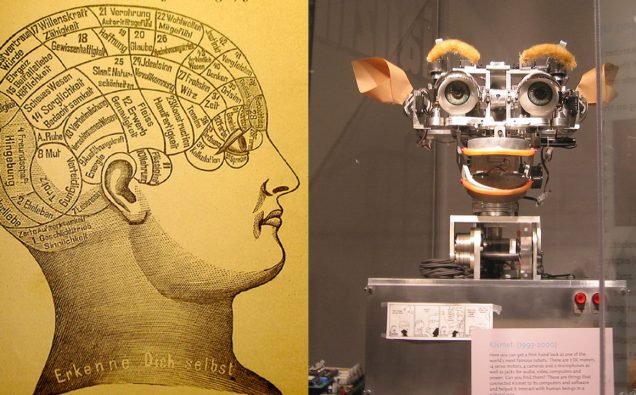
Collage photos:Phrenology (Left scanned by de:Benutzer:Summi and Kismet Robot (right) by Polimerek in MIT Museum/Wikimedia
Can you distinguish between “Deep Learning” and “Machine Learning.”? What about “artificial intelligence”? Let’s start with the definition of artificial intelligence because this is where it all begins.
Artificial intelligence (AI), “the ability of a digital computer or computer-controlled robot to perform tasks commonly associated with intelligent beings.”
Simply put, AI is a technology that enables a machine (computer/robot) to make an intelligent decision or take action. Academically speaking, “AI technology enables an intelligent agent to cognitively perceive its environment and correspondingly attempt to maximize its probability of success of target action.” In this context, a hardware module, software, a robot, or an application is “an intelligent agent,” The discipline of AI is probably older than you 🙂 Following excerpt is from 1953.
“We propose that a two-month, 10-man study of artificial intelligence be carried out during the summer of 1956 at Dartmouth College in Hanover, New Hampshire. The study is to proceed on the basis of the conjecture that every aspect of learning or any other feature of intelligence can in principle be so precisely described that a machine can be made to simulate it. An attempt will be made to find how to make machines use language, form abstractions and concepts, solve kinds of problems now reserved for humans, and improve themselves. We think that a significant advance can be made in one or more of these problems if a carefully selected group of scientists work on it together for a summer”.
Moving on to Machine learning (ML) which has evolved from pattern recognition and computational learning theory in AI. ML is the capability of a computer to learn without being explicitly programmed. It is functionality to learn and make predictions from data.
![Artificial Intelligence Photo: Alejandro Zorrilal Cruz [Public domain], via Wikimedia Commons](https://upload.wikimedia.org/wikipedia/commons/1/1c/Artificial.intelligence.jpg)
Artificial Intelligence Photo: Alejandro Zorrilal Cruz [Public domain], via Wikimedia Commons
“Machine Learning is the science of getting computers to learn and act like humans do, and improve their learning over time in autonomous fashion, by feeding them data and information in the form of observations and real-world interactions.”
- “Machine learning is the science of getting computers to act without being explicitly programmed.” – Stanford
- “Machine learning is based on algorithms that can learn from data without relying on rules-based programming.”- McKinsey & Co.
- “Machine learning algorithms can figure out how to perform important tasks by generalizing from examples.” – University of Washington
- “The field of Machine Learning seeks to answer the question “How can we build computer systems that automatically improve with experience, and what are the fundamental laws that govern all learning processes?” – Carnegie Mellon University
A neural network is composed of simple processing nodes, or ‘artificial neurons’, which are connected to one another in layers. Each node will receive data from several nodes ‘above’ it, and give data to several nodes ‘below’ it. Nodes attach a ‘weight’ to the data they receive, and attribute a value to that data. If the data does not pass a certain threshold, it is not passed on to another node. The weights and thresholds of the nodes are adjusted when the algorithm is trained until similar data input results in consistent outputs.
Now let’s talk about “deep learning.”
“Deep learning is a machine learning technique that uses multiple internal layers of nonlinear processing units to conduct supervised or unsupervised learning from data.”
Deep learning literature borrows from neuroscience, and implemented as “a neural network.” You will find academics and practitioners of this field talk about “neurons and perceptrons.” Relax – they are not going to operate on your brain.
Simply put, the nonlinear processing units are commonly referred to as the neurons. Automation became possible due to AI technology. Machines become capable of automated learning and making decisions due to machine learning technology. Moreover, precision details are cognitively noticed in the automated learning process and used in the accurate decision making of complex problems due to deep learning technology.
A more recent variation of neural networks, which uses many layers of artificial neurons to solve more difficult problems. Its popularity as a technique increased significantly from the mid-2000s onwards, as it is behind much of the wider interest in AI today. It is often used to classify information from images, text or sound.
















